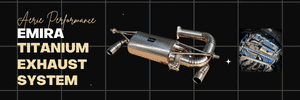This was posted before, but buried on another thread so pasting it here.
For the V6 it should be the same as the V6 Evora so 1,000 miles to the first inspection and oil change, with the first 600 miles below 4,000rpm. This from the Evora handbook:
Running-In
Although the Evora powertrain is built to close tolerances using modern technology, the progressive and sympathetic running-in (or bedding-in) of a new engine and transmission, remains a valuable contributor to achieving the highest levels of efficiency, durability, smooth operation and economic performance. By following the simple guidelines described below, a solid foundation will be built for the car's lifetime career.
NOTICE
Failure to comply with the following running-in provisions could invalidate the terms of the New Vehicle Warranty:
Engine: It is important during the car's early life, not to overload the engine, and to control the amount of engine heat generated. This is dependent primarily on throttle opening (accelerator position) and engine speed. However, being too sympathetic on the car will not allow the piston rings to bed in satisfactorily, so a balance of spirited and gentle use is required. For the first 600 miles (1,000 km), use no more than moderate throttle openings (about half of the available accelerator pedal travel) and do not run the engine continuously at engine speeds over 4,000 rpm. Occasional short bursts at wider throttle and higher engine speed will be beneficial, as will a constantly changing cruising speed and making full use of the gearbox. Do not allow the engine to labour in too high a gear ratio; change down and let the engine operate in its natural power band.
After 600 miles (1,000 km) have been covered, full throttle and/or maximum engine speed may be used for short periods, but do not attempt to exploit full vehicle performance until after the first 'After Sales' service has been carried out.
Transmission: Driving pleasure will be enhanced when using a light touch to guide the gear lever, allowing the tactile senses to convey gear selection messages from the internal mechanism. Forcing the change will cause unnecessary wear on system components and impair subsequent gearchange quality.
Brakes: Allow the brakes to bed-in by avoiding needless heavy braking for the first 100 miles (160 km). Thereafter, the first time the brakes are used aggressively, some loss of brake feel may be evident as the brake pads undergo a final conditioning phase. After the brakes have cooled, full brake performance will be restored. Both the brake pedal and gearchange efforts are likely to reduce during the running-in period.
Tyres: New tyres also require a short 'running-in' period before providing optimum grip.
Note that various operating parameters are continuously monitored and recorded in the engine electronic controller. This data may be downloaded by Lotus dealers on demand in order to assist with fault diagnosis and identify any vehicle misuse.
Stopping the Engine
After running the engine at high speed or under heavy load and generating substantial engine heat, if possible before switching off the engine, drive for a short period in a gentler manner, or allow the engine to idle for a few minutes in order for normal temperatures to be resumed. This consideration will reduce the effects of heat soak, and benefit the long term durability of the powertrain.
Most of all have fun with your new car.
And with thanks to
@JumboJet, this is from Mercedes A series handbook, so relevant for the AMG i4:
Running-in notes
To preserve the engine during the first 1,500 km:
R Drive at varying road speeds and engine speeds.
R Do not drive at speeds greater than 140 km/h.
R Drive the vehicle in drive program A or ;.
R Shift to the next highest gear at the very lat‐ est when the needle reaches the last third before the red area in the rev counter.
R Donotshiftdownmanuallyinordertobrake.
R Avoidoverstrainingthevehicle,e.g.drivingat full throttle.
R Vehicleswithautomatictransmission:do not depress the accelerator pedal beyond the pressure point (kickdown).
R Only increase the engine speed gradually and accelerate the vehicle to full speed after 1,500 km.
This also applies when the engine or parts of the drivetrain have been replaced.
Please also observe the following running-in notes:
R In certain driving and driving safety systems, the sensors adjust automatically while a cer‐ tain distance is being driven after the vehicle has been delivered or after repairs. Full sys‐ tem effectiveness is not reached until the end of this teach-in process.
R Brakepads, brake disks and tyres that are either new or have been replaced only ach‐ ieve optimum braking effect and grip after several hundred kilometres of driving. Com‐ pensate for the reduced braking effect by applying greater force to the brake pedal.








